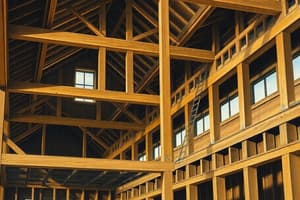Podcast
Questions and Answers
Which type of mortar is recommended for use in reinforced masonry below grade or in contact with the earth, as foundation and retaining walls subject to high lateral or compressive loads?
Which type of mortar is recommended for use in reinforced masonry below grade or in contact with the earth, as foundation and retaining walls subject to high lateral or compressive loads?
- Type S mortar
- Type O mortar
- Type N mortar
- Type M mortar (correct)
What is the compressive strength of Type S mortar?
What is the compressive strength of Type S mortar?
- Not specified
- 2500 psi (17,238 kPa)
- 750 psi (5,171 kPa)
- 1800 psi (12,411 kPa) (correct)
Where is Type N mortar recommended for use?
Where is Type N mortar recommended for use?
- In masonry where bond and lateral strength are more important than compressive strength
- In exposed masonry above grade where high compressive and lateral strength are not required (correct)
- In interior non-load bearing walls and partitions
- In reinforced masonry below grade or in contact with the earth
What is the compressive strength of Type O mortar?
What is the compressive strength of Type O mortar?
Where is Type K mortar suitable for use?
Where is Type K mortar suitable for use?
What is the main ingredient in Concrete Block or Cement Block?
What is the main ingredient in Concrete Block or Cement Block?
What is the recommended use for Type S mortar?
What is the recommended use for Type S mortar?
What is the purpose of the aggregates used in Concrete Block or Cement Block?
What is the purpose of the aggregates used in Concrete Block or Cement Block?
What is the compressive strength of Type N mortar?
What is the compressive strength of Type N mortar?
Which type of mortar has the highest compressive strength?
Which type of mortar has the highest compressive strength?
Flashcards are hidden until you start studying





